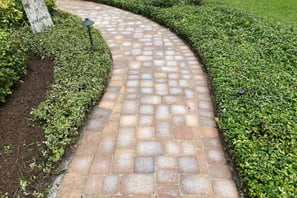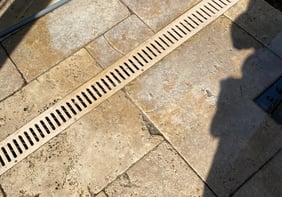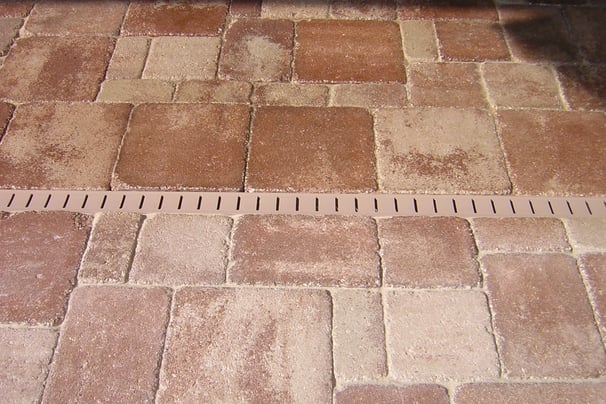
Paver Sealing
Specializing in paver sealing for commercial and residential properties in Tampa Bay since 1998.
Frequently Asked Questions About Paver Sealing
Is Paver Sealing a Good Idea in Florida?
Yes. In Florida's climate, pavers require protection and maintenance. My rule is that if you hardly ever use them and your pavers are high and dry, shaded and protected from the elements and have good drainage, then you probably don't need to seal them. But for everyone else, the intense sun, high humidity, social activities and heavy rainy season here can take a toll on pavers rather quickly. It's not uncommon to see holes bored into pavers from the water dripping off the gutters and often these pavers are less than 4 years old. *Tip: Use flower pots or sacrificial stones to protect your pavers where your gutters drip and remove them when needed.
But you should be aware that sealing will NOT stop mold and mildew from forming ON your pavers anymore than it will keep it from growing on a car because mold will form anywhere moisture is slow to evaporate. But paver sealing WILL make them easier to clean and more "resistant" to mold, mildew, tire and shoe marks, spills and weathering.
Paver sealing isn't a "set and forget" solution for your pavers. Spills still need to be cleaned up. But a sealer does give you more time to clean it up so that it doesn't permanently stain your pavers.
How Often Do I Have to Seal Pavers?
Generally, you should seal every 2 to 3 years depending on the the wear and tear your pavers receive. That's why it's important to make sure you are using the correct sealer so that you can get the longest lasting protection possible for your pavers for the best price. What's the point of paying hundreds more just to last another year. Pavers that get very little wear and tear and are protected from the weather and sun, such as a covered lanai, can last 4 to 5 years.
It is important to note that once you start sealing your pavers, that you know the TYPE of sealer (solvent vs water, acrylic vs urethane vs silicone) you are purchasing and if you are hiring someone else to do it, try to stay with the same company so that they are using the same or most compatible sealers for your application. A different company that is unfamiliar with the old sealer may need to completely strip and remove your old sealer in order to warranty their work and this can easily triple the cost of your paver sealing.
When we reseal your pavers again in 2 to 3 years, we'll be using the same sealer and it will be easier and less expensive than hiring someone new who is unsure of what type of sealer we used. Usually, once we seal your pavers, it is just a matter of cleaning to reseal. I have a customer that I have sealed his pavers every 3 years for the past 15 years and his cost averages $1 per square foot.
How Much Does it Cost to Seal Pavers?
Here in Florida, paver sealing costs range from $1.50 to over $3 per square foot. But this is because it depends on the type of sealer you are using, time needed to work around structures like planters, pools, walls and cage frames even how much cleaning, stripping and prep time will be needed and of course, whether or not you will be re-sanding your pavers.
Two part sealers like polyurethanes are the most expensive. They require more expertise to apply because you only have a limited amount of time to apply it once it is mixed. Acrylic sealers are mid priced and easier to apply while silicone based sealers are the least expensive and the easiest to apply. But know this, once you apply a silicone based sealer, you can never go to another sealer. Ever. Silicone sealers cannot be stripped and removed once applied. All others can be stripped and removed but that often doubles or triples the price.
Re-sanding is the most time consuming and back-breaking part of the job because it is critical that you take your time to fill the joints completely. If you are using polymeric sand, you should mix it up before using it by pouring it into a five gallon bucket to remix the polymers with the sand due to settling during the shipping to your point of purchase. You must also limit the amount of time that you push polymeric sand around with your broom as too much sweeping can also cause the polymer adhesives to separate from the sand which means your sand will not harden correctly. You will know when polymeric sand doesn't cure correctly, because you will have loose sand and gaps between your pavers. Your sand will also get washed away during heavier rains.
On average, we charge $1.25 per square foot for cleaning and sealing only. Sanding is an additional $1 per square foot, so $2.25 per square foot for a wet look, acrylic sealer with polymeric sand. But if you are trying to figure out your square footage yourself, don't subtract for the pool or planters because it takes more time to apply the sealer by hand on or around the pool coping, planters, walls and pool cage frames than it would to roll out the same size area if it were just flat.
What is the Best Sealer for Florida Weather?
In my opinion, the best sealer is the one that gives you the least amount of issues and is the easiest one to fix when something goes wrong. I prefer solvent based sealers because they are extremely durable and the new sealer will more completely bond with the old sealer.
In the pictures below, you can see why I don't use water based sealers. In the first picture, we have a walkway was sealed with a water based sealer less than 6 months before and it had to be stripped completely in order to remove the cloudiness. In the second picture, the cloudiness on this pool deck was caused by a rubber mat that didn't allow the sealer to dry out. Again, the sealer had to be completely stripped away.
The stripping of someone else's work was extremely time consuming and costly because you can't just seal over it. Otherwise, you're sealing in the "cloudiness" which would be permanently locked into the new sealer if not removed. If this were a solvent based sealer instead of a water based sealer, this cloudiness would most likely have been removed within a few minutes instead of weeks.






Can I Seal My Pavers Myself?
Yes, you can! I'll be happy to clean your pavers for you and get them ready for sealing. Let them dry out for a couple of days and you get to enjoy the most fun part, rolling on the shine and bringing back the color - after you do the cutting in around your walls and pool cage frame with your brush, of course. For "most" pool decks, it takes about an hour to use a brush to hand paint in around walls and pool cage frames so that your roller can stay 2 inches away from everything when applying the rest of the sealer. Painting around the pool coping and planters will add some extra time.
I'll be happy to help you select the right sealer for your application, the right size rollers and brushes you'll need for cutting in around vertical structures and pool coping.
The main issue we have to watch is the amount of moisture your pavers hold. Pavers that are always damp or cool may not be good candidates for sealing. In fact, if you have areas where you get standing water, then you may want to skip sealing that area altogether.
And lastly, when it comes to filling the joints with sand, I recommend resanding your pavers before you seal them so that you are sealing the sand as well. Of course, you can sand them after your seal them, but sealing them will give them an added layer of protection against wear and tear and breakdown of the the polymer adhesives that keep the sand in place.
Paver Cleaning and Maintenance
How can I keep my pavers looking new?
To keep your pavers looking their best, you will need to sweep off debris and dirt about once a month. Even using a small battery powered blower will go a long way to keeping your pavers clean. Dirt and grime if left alone will become harder to remove over time as they slowly "bond" to the surface. They may even begin to stain your paver and in some cases, these stains can become permanent. Today's modern concrete paver originated in the Netherlands. But in the Netherlands, they don't seal pavers like we do here. They just replace them due to wear or because of reconstruction. Here, we need to protect them from the sun, chemicals, food stains, tire marks and automotive fluid spills. Sealing your pavers will help prevent dirt and debris from penetrating the stone’s pores and keep them looking fresh and new.
Can I pressure wash my pavers?
Yes, it is usually safe to pressure wash pavers, but it's important to use a low-pressure setting and the correct nozzle size to avoid damaging your pavers or blowing out the joint sand. When possible, use a rotary surface cleaner because it will minimize the removal of your joint sand. Test on a small, inconspicuous area first to ensure no harm is done.
How often should I clean my pavers?
Cleaning frequency for pavers depends on their exposure to dirt and weather conditions. Generally, it's recommended to perform a thorough cleaning at least once a year to maintain their appearance. However, applying a protectant can extend the interval between these thorough cleanings to every three years, preserving the pavers while reducing maintenance efforts.
Services
Soft washing
Pressure washing
Paver sealing
© 2024. All rights reserved.
PROFESSIONAL
INSURED
AFFORDABLE
Scrubbing Bubbles Exterior Cleaning Services
Mobile: 813-298-2059 Office: 813-802-6431
